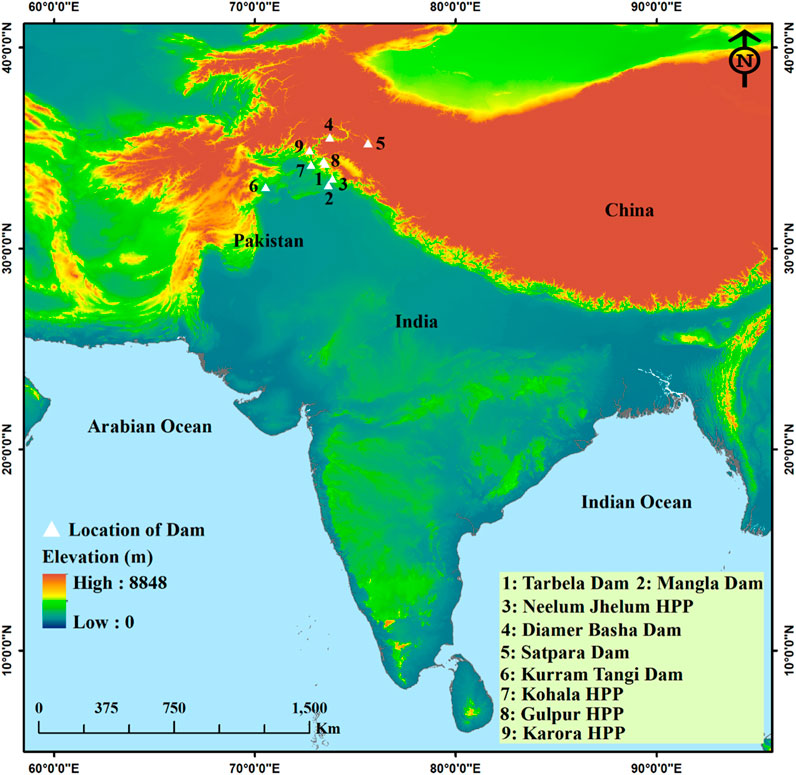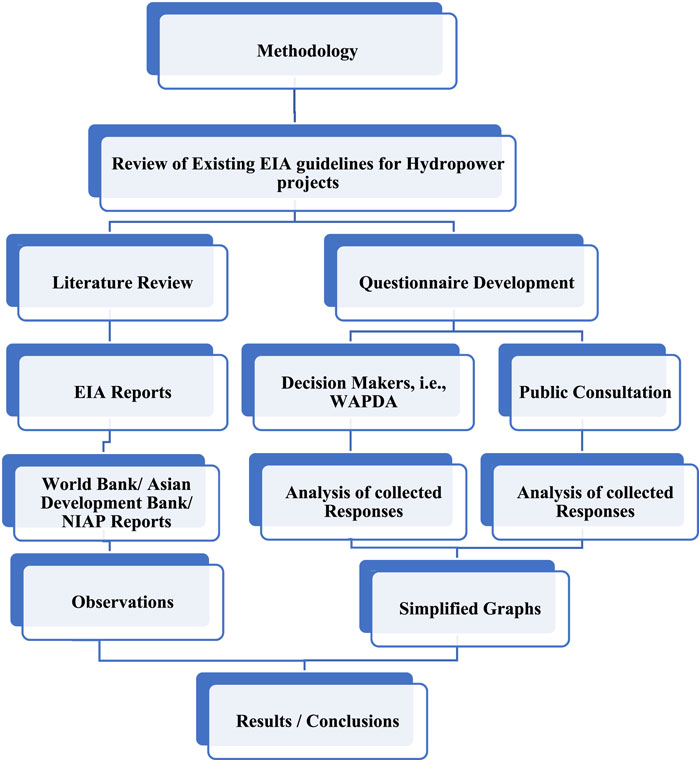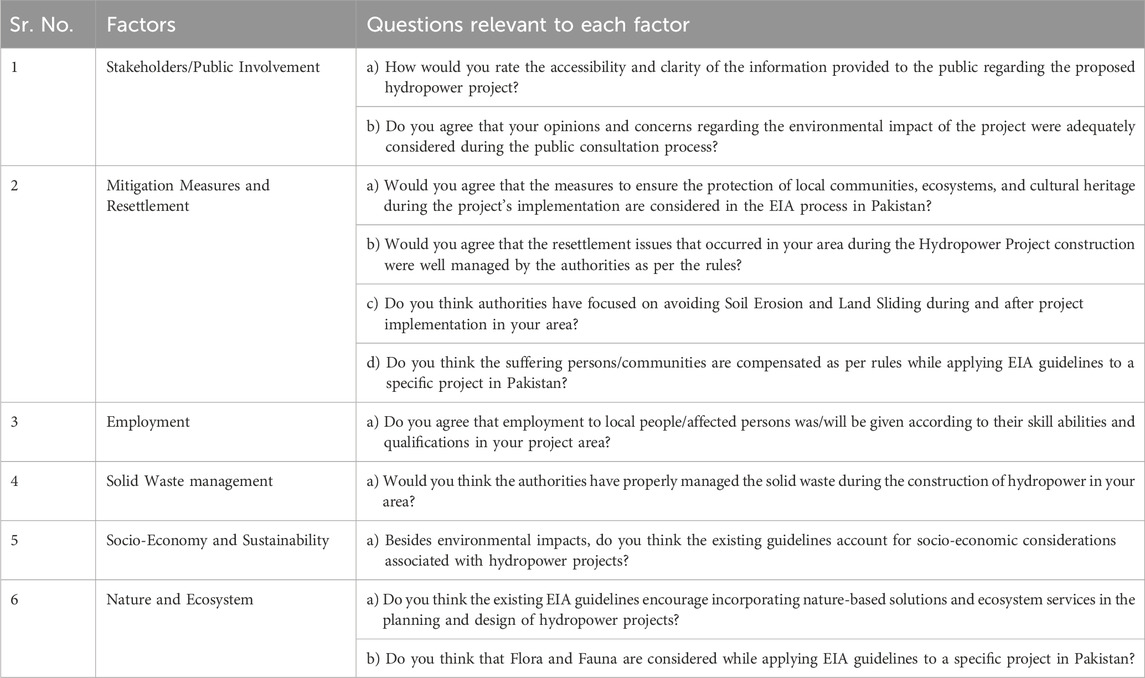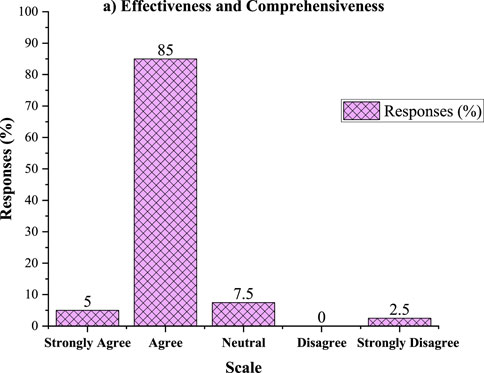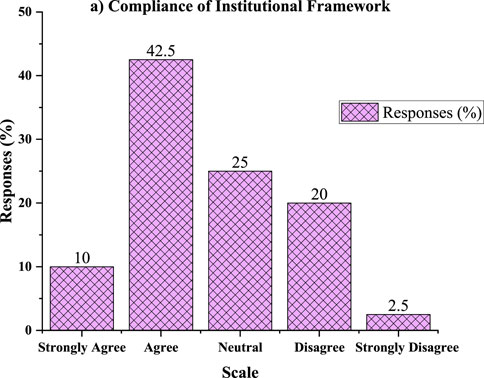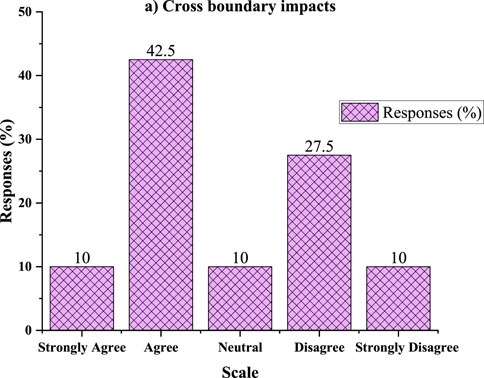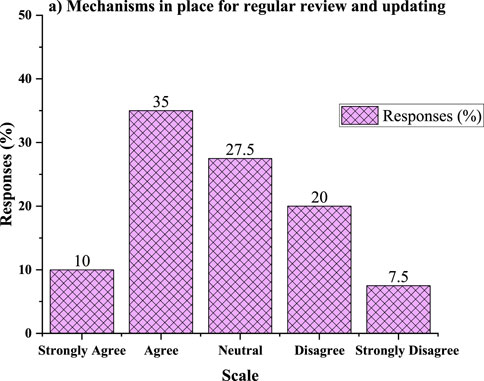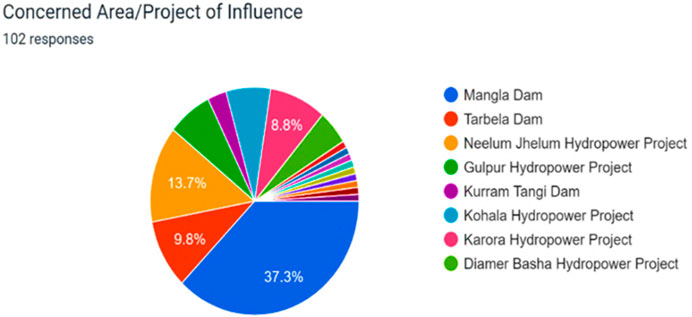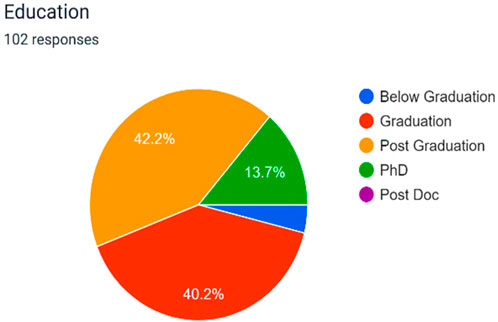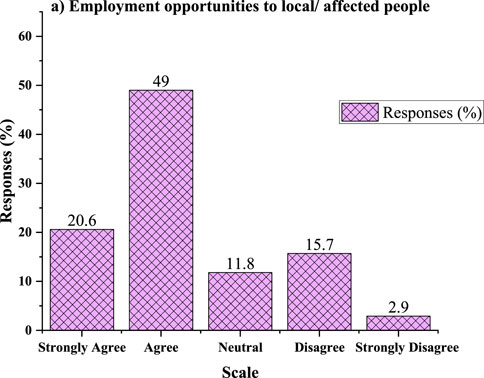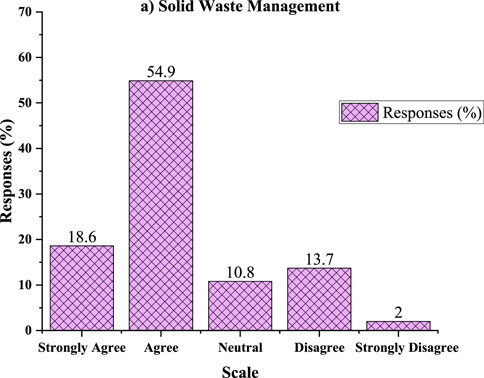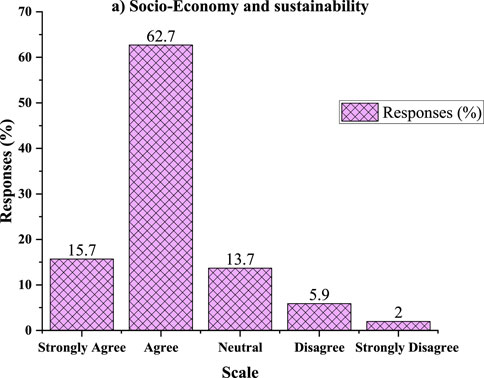- 1State Key Laboratory of Cryospheric Science, Northwest Institute of Eco-Environment and Resources, Chinese Academy of Sciences, Lanzhou, China
- 2University of Chinese Academy of Sciences, Beijing, China
- 3China-Pakistan Joint Research Center on Earth Sciences, CAS-HEC, Islamabad, Pakistan
Introduction: More than 16% of the total electricity used worldwide is met by hydropower, having local to regional environmental consequences. With positive indicators that energy is becoming more broadly available and sustainable, the world is moving closer to achieving Sustainable Development Goal 7 (SDG 7). Pakistan became the first nation to include the Sustainable Development Goals (SDGs) in its national development strategy.
Methodology: The current study sought to investigate the structural limits of Environmental Impact Assessment (EIA) guidelines for hydropower development in Pakistan. The study included the document review of the EIA reports about hydropower projects in Pakistan, scientific questionnaires from decision-makers, and public consultation.
Results and Discussion: The document evaluates that an adequate mechanism is available, and donors like the Asian Development Bank and World Bank observe the implementation process of EIA in Pakistan. However, a comprehensive analysis of the EIA system found several things that could be improved, not only in the institutional framework but also in actual implementation and practices. More than 20% of respondent decision-makers disagreed with the compliance of the current Institutional Framework with EIA guidelines, and 25% think that the existing guidelines followed in Pakistan are not aligned with international standards and practices for Hydropower in actual practice. EIA has a limited impact on decision-making due to insufficient technical and financial resources.
Recommendations: There should be a think tank with experts who can meet the needs of present and future epochs. The public should be communicated with and educated about EIA. For better efficiency, the officers and decision-makers should be trained internationally, i.e., the Water and Power Development Authority (WAPDA).
1 Introduction
Environmental Impact Assessment (EIA) is one of the most significant examples of recent legislation that sought to maintain a balanced relationship between the environment and development (Alaeddin, 2017). More than 16% of the total electricity used worldwide is met by hydropower, which also generates 71% of all renewable energy. Many nations have increased their renewable energy portfolios, including considerable expenditures in massive hydropower development, to meet global carbon reduction goals (McManamay et al., 2020). Current hydroelectric projects might boost the world’s hydropower capacity by 73%, with some estimates going as high as 100%. Hydropower development has local to regional environmental consequences, such as changes to river ecosystems, even while it offers a flexible renewable energy resource to supplement variable sources of electricity such as solar and wind (McManamay et al., 2020).
With positive indicators that energy is becoming more broadly available and sustainable, the world is moving closer to achieving Sustainable Development Goal (SDG) 7. Energy efficiency is advancing, renewable energy is making significant progress in the electrical industry, and access to electricity in less developed nations is starting to pick up speed. The study was influenced by SDG goal 7, “Ensure access to affordable, reliable, sustainable, and modern energy.” It specifically targets SDG 7.1, i.e., by 2030, all people should have access to affordable, reliable, and modern energy services, and SDG 7.2, i.e., by 2030, the share of renewable energy in the world’s energy mix should have increased significantly (UNRIC, 2023). Even though the state’s economy benefits from expanding hydropower capabilities, it also causes environmental harm and disputes over the reallocation of land and water resources (Lata et al., 2017; Sinclair and Diduck, 2000). Lack of meaningful involvement by the public in the dam construction process is a key critique, (Rajaram and Das, 2006), which is especially essential for local communities that are directly impacted by hydropower projects (Diduck et al., 2007; Paliwal, 2006). Countries have various policies to assess the environmental effects of hydropower development, operation, and mitigation measures. A requirement for EIA, though with different processes in different nations, is one thing all regulations have in common (UN United Nations - Environment, 2018). Authorities may find it difficult to ensure whether EIA processes can keep up with the pace of development in areas where hydropower development is most dynamic and rapid (Erlewein, 2013) or implemented at all in certain circumstances.
As a renewable energy source, hydropower is a versatile, dependable, and economical source of electricity generation (Butt et al., 2023a) and sustainable water-resource management (Afzal et al., 2023). Although hydropower offers a versatile renewable energy source to supplement fluctuating energy sources (such as solar and wind) (Solomon et al., 2017; Hoes et al., 2017), hydropower production has regional and local environmental consequences, such as changes to river ecosystems (Ansar et al., 2014; Kibler and Tullos, 2013). Due to its unique characteristics and commitment to sustainability, hydropower has become a powerful force in the struggle to solve the world’s energy issues (Butt et al., 2023b). It reflects a chance to meet the ongoing demand for energy brought on by growing populations and economies while also maintaining standards for the environment (especially the rise in greenhouse gas releases and global warming, along with climate change concerns) and simultaneously improving social wellbeing by providing power to underdeveloped along with remote regions (Banerjee et al., 2023; Banerjee et al., 2021). This is important because it recognizes the underlying resource finiteness and depletion (Botelho et al., 2017). To meet the global carbon reduction goals, many countries have grown their renewable energy portfolios (McDonald et al., 2009; Zimny et al., 2013) making significant expenditures in the construction of large hydropower plants (Zarfl et al., 2015).
Pakistan Environmental Protection Ordinance (PEPO) 1983 established EIA as a mandate in Pakistan. Pakistan Environmental Protection Act of 1997 (PEPA'97), which took the role of PEPO in 1997, increased the legal requirement for EIA and created the IEE EIA Review Rules of 2000. EIA Guidelines from 1986, EIA Energy Sector Directions from 1992, EIA Policies for Oil and Gas Investigating in Environmentally Sensitive Regions from 1997, Sub-sectoral Guidelines from Khyber Pakhtunkhwa EPA for 22 sectors, and Sub-sectoral Guidelines from Baluchistan EPA for three sectors are a few of the notable guidelines. (NIAP, 2014). By adopting the Sustainable Development Goals (SDGs) as the country’s national development plan through a unanimous National Assembly Resolution in 2016, Pakistan affirmed its dedication to the 2030 plan for Sustainable Development. Through a National Assembly Resolution, Pakistan became the first nation in the world to include the Sustainable Development Goals (SDGs) in its national development strategy. Pakistan has made significant investments to address energy shortages, boost energy production, and increase access to electricity to advance SDG 7 more quickly. Access to power has increased by 8% over the previous 10 years. In Pakistan, efforts are being made to increase the proportion of renewable energy to 20% by 2025 and 30% by 2030 (Government of Pakistan, 2019).
Looking at the vast amount of available research/studies on EIA (Wang et al., 2012; Rashad and Ismail, 2000) many diverse contributions (Ortolano and Shepherd, 1995) have been made to evaluate the effectiveness of national EIA systems (Jumani et al., 2017; Kuriqi et al., 2021). The US, Canada, and the EU have all produced well-known comparative and transnational research (McManamay et al., 2020; Pinho et al., 2007a). Others have focused on the technical and scientific content of EIA reports and their overall quality (Lee and Tomkins, 1993; Wende, 2002). The importance of EIA for both small- and large-scale hydropower projects has been highlighted by numerous scholars across the globe (Tzoumis and Finegold, 2000). The research by (Botelho et al., 2017) highlighted the value of using a case study technique to establish priorities for alternative hydropower producing facilities. They demonstrated that benefit transfer should not be used because each hydropower plant has unique and different impacts through the evaluation of assessment studies on the environmental effects of hydropower and the analysis of the various environmental impacts linked to hydroelectric power for particular cases. Finally, they showed that being pertinent for policy design, choice trials were particularly well adapted for valuing the discovered environmental impacts. The overall environmental impacts of 3 major hydropower developments and 27 small hydropower resources were examined in Norway by (Bakken et al., 2012). They concluded that it was reasonable to imagine that a few major hydropower projects would generate electricity at a lower environmental cost than many small projects, which must be considered when accomplishing the government’s renewable energy objectives. Other benefits, such as the provision of regulated power, were also considered.
The small hydropower (SHP) plant’s environmental impact was evaluated by (Zeleňáková et al., 2018). They determined how an SHP plant in Spiské Bystré, Slovakia, affected the environment. The alternatives to a certain hydraulic structure were also evaluated quantitatively from the standpoint of the nature, importance, and duration of the impacts. It was determined that it is much more difficult to eliminate the harmful effects of construction on the environment than to put preventive measures into place. As a result, it is crucial to evaluate the environmental effects of the proposed activities during the planning stage. Using river function indicators, an initial and general evaluation of the most relevant impacts of hydropower on the essential components of the river ecosystem, (McManamay et al., 2020), devised a weight-of-evidence approach (and toolset). A science-based questionnaire with a predictive model allows users to identify environmental indicators that could be impacted by hydropower development and those that are the most uncertain and require further study. In the Indian state of Himachal Pradesh (Erlewein, 2013) sought to investigate the structural limits of environmental evaluation for hydropower development. Employing a qualitative methodology that involved document reviews, field observations, and interviews with environmental specialists, the study concluded that the current practice of limiting EIAs to the project level misses the opportunity to address the wider implications of significant hydropower development. Therefore, the potential for the Strategic Environmental Assessment (SEA) paradigm to address current issues was critically explored.
A thorough analysis of every EIA Report that served as the foundation for successful EIA processes was conducted by (Pinho et al., 2007b) involving small-scale projects under the previous 2 decades’ worth of national EIA legislation and reported the findings of a 1-year study that sought to evaluate the caliber of EIA studies completed for Portuguese small hydropower projects. The review of past studies on comparable research projects completed in other EU nations helped shape the creation of the evaluation criteria. The evaluation exercise exposed various methodological and technological flaws in a sizable portion of cases. By performing semi-structured interviews with local people, (Jumani et al., 2017), evaluated how the four SHPs in India’s Western Ghats were believed to have affected socio-ecological conditions. Respondent perceptions were then contrasted with the anticipated baseline of assured impacts after the primary interview data was successfully validated with secondary data. The development of SHP and rising levels of human-elephant conflict were found to be closely related. The studies recommended that rules about SHPs be appropriately changed in light of the discrepancy between assured and actual societal consequences. The life cycle of an Indonesian micro hydro plant was evaluated by (Hanafi and Riman, 2015) at Simalungun using SimaPro software. For EIA from 1990 to 1997, (Daini, 2000), planned to use the hydroelectric plant in Trentino, Italy, starting with the unique characteristics of environmental projects, locations, and EIA studies, detect similarities in data structures using a particular index as well as multivariate statistical methods. The primary environmental effects brought on by RFS standards were analyzed by (Souza-Cruz-Buenaga et al., 2019) while considering the various water uses unique to each dam site, highlighting significant ecological, social, and economic implications since a good assessment of the RFS requirements prevents potential biological community instability and potential biodiversity loss.
A project must go through a thorough procedure that considers how it will affect the environment and nearby communities before being developed. Considerations include water quality, water flow, watershed management, habitat protection, fish passage, and the welfare and way of life of the surrounding communities. There are numerous environmental effects of hydropower plant projects. Naturally, these effects will differ from case to situation (Sayadi et al., 2009). Only after a thorough analysis of the locations of intended energy recovery, by the proposed technological solutions of hydropower structures, and as part of their pre-project and project preparation is an evaluation of the quantity of organic hydropower potential conceivable (Zelenakova et al., 2013). The study’s aim was to evaluate and review the current EIA guidelines for evaluating the various environmental effects of hydropower projects. Thus, the primary objective of the research was to examine the existing regulations for EIA and mitigation measures for hydropower projects in Pakistan by assessing the relevant documents and analyzing the feedback after scientific questionnaires filled by stakeholders.
The goal of improvement in the existing guidelines of EIA followed in Pakistan for the development of hydropower projects indicate the significance of presented methodology. The scientific questionnaires from both decision makers and public make the research novel to analyze the EIA guidelines followed in Pakistan for the development of hydropower projects, because the feedback data gathered from the stakeholders has spoken loud about the implementation of guidelines in paperwork as highlighted in the documents and reports. So, the study considered not only the paperwork but also tried to accommodate the ground realities of implementation of the EIA guidelines in Pakistan by getting feedback from the decision makers and public.
2 Study area
Pakistan is a significant country within the global south including large-scale undulating surface topography, wide range of plain lands, remarkable natural resources, and rapid increase in population growth collectively enhance the necessity to reveal adequate information on environmental and socio-economic scenarios moving to achieve sustainable development goals (SDGs) (Shangguan et al., 2021). The country ranges between 24° N and 37° N latitude and 61° E to 76° E longitude covering 7,96,095 km2 area, which surrounded by India, Afghanistan, China, Iran and Arabian Sea as depicted in Figure 1. The elevation of this region ranges from 0 m (in south) to 8,238 m (in northern hills) comprising large-scale glaciers, perennial rivers and deserts. Climatologically, this region lies in sub-topical weather system, albeit partly witnesses with arid to semi-arid features. The maximum temperature during the monsoon season (JJAS) goes up to 53.5°C, while winter experiences −19.48°C in northern areas (Almazroui et al., 2020). Additionally, maximum annual rainfall occurs during the monsoon season (55%) trailed by pre-monsoon and winter (DJFM) in accordance with onset of Indian Summer Monsoon (ISM) and Western Disturbances (WDs) respectively. Regionally, most of perennial rivers in Pakistan are comprising micro to macro scales hydropower project, which provides an indispensable electric and water supply throughout the country (Haq ul et al., 2022). Socio-economically, a marked increase in regional population was perceived in the last several decades averaging 1.8%. Increased climate variability, large-scale disasters, rapid population growth and associated land alterations collectively make this region vulnerable to future changes and require precise environmental impact assessment techniques for sustainable development (Sengupta et al., 2020). Figure 1 is showing the targeted sites for the study.
3 Methodology
The research employed a qualitative methodology as an original research comprising on assessment of documents/reports on EIA and collecting responses from the decision makers/environmental specialists in Hydropower projects, and public consultation through scientific Questionnaires, as depicted in Figure 2. Both Questionnaires were prepared using the Google Forms (Google, 2023). Google Forms was selected as the primary means of gathering data to collect survey data for the study. Google Forms offered a simple and effective platform for creating and sending the survey to the intended audience. A personalized survey questionnaire was created using the Google Forms interface to start the process. The platform made it possible to include different kinds of questions, which made it possible to explore the research thoroughly. Once both questionnaires were designed, a special URL to the Google Forms was created. The intended participants were then informed of this link through email, social media, or other means of communication.
3.1 Observations through document reviews
After a thorough review of EIA studies and the available documents relevant to the implementation of Environmental Impact Assessment for hydropower projects in Pakistan by the National Impact Assessment Program (PPIB, 2014), Asian Development Bank (National Development Consultants, 2007), Hagler Bailly Pakistan (Nadeem and Hameed, 2008), Mira Power Limited, (Asian Development Bank, 2018), National Development Consultants (Hagler Bailly Pakistan, 2018) etc., along with the EIA reports about hydropower projects in Pakistan by (Muazzam, 2018; Ahamd et al., 2009; Dutch Sustainability Unit, 2015) perceptions about the contents of the guidelines (Mira Power Limited MPL, 2014; Asian Development Bank, 2021), for preparation and review of an EIA reports and the guidelines (Annandale, 2014; NEPRA, 2019). Pakistan Environmental Protection Agency (Pak-EPA) sectoral guidelines (GRC, 2016; PEDO, 2016) for major dams/hydropower projects were sought in the current study. For major dams, the legal provisions for EIA, and the guidelines for the development and assessment of environmental studies are being examined.
From a detailed study of the report “EIA Guidance for Large-Scale Hydropower in Pakistan” by the National Impact Assessment Program (NIAP, 2014), it is evident that Several policies and processes have evolved during the past 20 years to guarantee the proper management of hydropower projects’ environmental and social implications. International Finance Corporation (IFC), Asian Development Bank (ADB), The World Bank Group, Equitable Principle Banks, Donor organizations like USAID, KfW, and JICA, and other international lending institutions’ more general social and environmental safeguards can be broadly categorized in these guidelines.
As per available studies, the Pakistan Environmental Protection Act has produced a set of environmental recommendations for carrying out environmental evaluations and managing different development projects. The EIA process starts with screening. The regulations are clear regarding which project kinds and sizes necessitate the more thorough EIA or the less thorough Initial Environmental Examination (IEE). An IEE is necessary for projects with installed capacities of less than 50 MW, reservoirs with storage volumes of less than 50 million m3 or surfaces larger than 8 km2. Regardless of the project’s size, a comprehensive EIA is necessary if the project is situated in or impacts a designated ecologically sensitive region. An IEE is needed for transmission lines with a voltage between 11 and 50 kV. Full EIAs are required for substations and transmission lines over 50 kV. Scoping is the process of determining what the most significant environmental implications are anticipated to be. Although the study is not done in detail, it is crucial to recognize the wide variety of implications. It establishes the direction for the entire EIA. It can identify the necessary research areas, making it possibly one of the most crucial steps in the process. The terms of reference for the consultants working on the EIA are best defined and developed using this information. EIAs are now universally acknowledged as a crucial component that must be included in the involvement of project stakeholders in project planning, design, and execution. According to Section 12 (3) of the Pakistan Environmental Protection Act 1997, “every review of an impact assessment on the environment shall be performed with public participation."
According to the National Impact Assessment Program (NIAP, 2014), the Land Acquisition Act of 1894 (LAA) governs the purchase of private property in Pakistan for public uses, including development projects including acquisition, area notices, surveys, awards for compensation, and apportionment, the resolution of disputes, penalties, and exclusions. The criteria for eligibility for compensation are typically divided into three groups: those who have legal title to the affected lands or assets that they use or occupy, those who do not but who do have claims to the affected land that are recognized or recognizable under national law, and those who do not have any legal right or claim to the land or resources they use or occupy.
3.2 Observations through questionnaires
After the detailed evaluation of documentation/EIA reports, two types of Questionnaires were prepared for the study to get feedback from the real stakeholders, including the decision-makers and locally affected people, beyond the documented statements. The first questionnaire (40 responses) was shared with the decision-makers, i.e., the senior officers of WAPDA. The second Questionnaire was shared with the local communities for public consultation by engaging with the educated public (102 responses) living in the influenced areas/regions in Pakistan where any Hydropower Project/Dam project was/will be in the construction or operational Phase.
3.2.1 Questionnaire for the decision makers
The Questionnaire for the Decision Makers, i.e., WAPDA was designed keeping several factors in view i.e., Effectiveness and Comprehensiveness of EIA, Economic Benefits of a hydropower project over Environment, Environmental Impacts, and mitigations as per rules, Institutional Framework for EIA, Consideration of Cross-Boundary Impacts, Stakeholders Involvement in decision making, Consideration of Climate Change, Alignment of existing EIA guidelines with International Guidelines, Mechanism for Updating Existing Guidelines of EIA, etc.
Both questionnaires were developed with every significant aspect considered to obtain a thorough analysis of the EIA guidelines that Pakistan is following in developing its hydropower projects, as explained below in Tables 1, 2. Table 1 summarizes the factors considered in making the questionnaire for the decision-makers and the relevant questions to each factor.
3.2.2 Questionnaire for the public consultation
The Questionnaire for the Public Consultation was designed to get real feedback from the public/Local community by keeping several factors in view, i.e., Stakeholders, Public Involvement in decision-making, Mitigation measures, and Resettlement due to construction of any hydropower project, Employment to the local communities, Climate Change and Sustainability, Socio-Economy, and Sustainability along with consideration of Nature and Ecosystem including the safety of Flora and Fauna during any hydropower project. Public feedback is the cross-judgment about the feedback of the decision makers and the documented statements. People were targeted from the different regions of Pakistan who were/are/will be affected or stakeholders during the EIA process for the development of a Hydropower Project in their area, including, Mangla Dam, Tarbela Dam, Neelum Jhelum Hydropower Project, Gulpur Hydropower Project Kotli, Kurram Tangi Dam, Kohala Hydropower Project, Karora Hydropower Project, Diamer Basha Hydropower Project etc. as shown in Figure 1.
Table 2 summarizes the factors considered in making the questionnaire for the public and the relevant questions to each factor.
4 Results
4.1 Responses from the decision makers
For the review of the EIA guidelines for Hydropower projects in Pakistan, a scientific Questionnaire was prepared, and responses were collected from the officers and Decision makers from the Water and Power Development Authority (WAPDA) Pakistan, which are working in the field of EIA for Hydropower in Pakistan. The summary result for all questions is provided below. Forty officers, including the Chief Engineer of Hydro Planning, Senior Engineer, Director, Executive Engineer, Resident Engineer, Environment, Health & Safety (EHS) Engineer, Assistant Director, Junior Engineer, Professional Engineer Construction Planning, and costing etc., from WAPDA, submitted their responses, which are shown below in Pie Charts question by question.
4.1.1 Effectiveness and comprehensiveness
The goal of EIA is to keep development and the environment in balance. Figure 3 depicts the response to questions asked to the decision-makers and officers of WAPDA about the effectiveness of the proposed mitigation measures in the existing EIA guidelines to minimize the Environmental impacts that are being followed in Pakistan for the EIA processes. More than 85% of respondents were confident in response. It shows a positive image of the proposed mitigation measures during the phase of EIA. If the proposed mitigation measures are not effective, then it means there is something wrong in the guidelines.
4.1.2 Economic benefits
Figure 4 talks about the weightage of the economic benefits over the environmental and social costs in Pakistan, and 75% of respondents agreed that the Economic Benefits of Hydropower have more weightage against its potential environmental and social costs. More than 10% of the decision-makers disagreed with the statement. Somehow, it is a bitter truth that the struggling economy of Pakistan needs cheap and affordable energy sources, and Pakistan is rich in hydel potential. So, it is the need of hour to build hydropower projects to fulfill the mega shortfall of energy. However, considering Environmental impacts before selecting suitable sites is more important.
4.1.3 Environmental impacts
The guidelines play an important role in any field, and their incorporation as per defined rules is most important. Figure 5A depicts that 65% of respondents agreed that the existing guidelines incorporate mitigation measures for potential environmental impacts of Hydropower projects in Pakistan. According to 15% of the decision-makers as a respondent, the existing guidelines could not fully incorporate the mitigation measures for potential environmental impacts of Hydropower projects in Pakistan. It depicts the need to update the existing guidelines regularly.
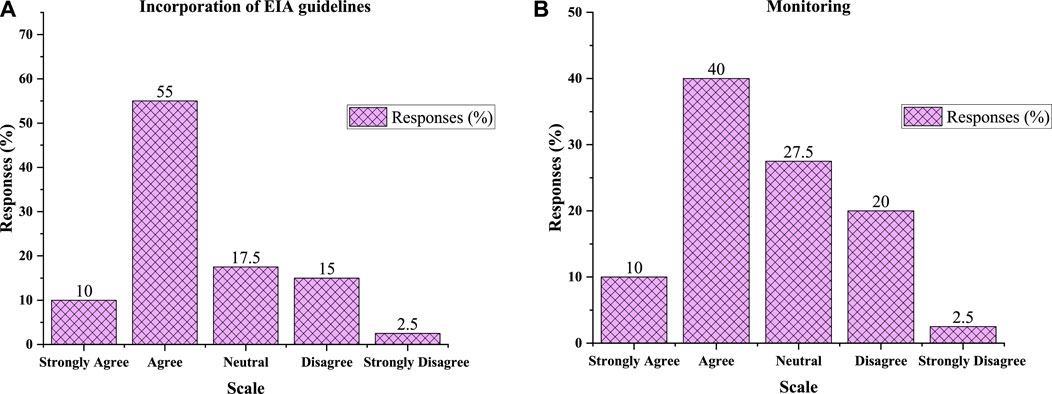
FIGURE 5. Response about Environmental impacts and monitoring. (A) Response about Incorporation of EIA guidelines (B) Response about Monitoring during and after implementation of EIA.
Moreover, only 50% of respondents agreed that the existing guidelines for monitoring the environmental impacts during and after project implementation are adequate, as shown in Figure 5B. Besides this, 22.5% of respondents disagreed. It highlights the need for change and updates in the existing EIA guidelines in terms of monitoring the environmental impacts even after the completion of the hydropower project.
4.1.4 Institutional framework
Institutional framework and breakdown are as important in a decision-making organization as the decision itself. As shown in Figure 6, more than 20% of respondents disagreed with the compliance of the current Institutional Framework with EIA guidelines and mitigation measures in Pakistan for Hydropower projects. 25% of respondents liked to remain neutral in this scenario. The disagreeing numbers are frightening as the institutional framework is not compliant with EIA guidelines; then how is it expected that the current framework will deliver the best efficiency? It means the EIA system will collapse.
4.1.5 Cross-boundary impacts
Cross-boundary water quality events have not only had a negative impact on the surrounding environment but have also put the water ecology and public health in the entire basin at risk (Zhang et al., 2018). More than 37% of the respondents disagreed with the consideration of Cross-boundary environmental impacts of Hydropower projects by Decision-makers in Pakistan, as shown in Figure 7.
The disagreement by more than 37% of respondents means that the downstream effects on water quality or transboundary species migration due to the construction of a hydropower project are not considered according to the currently followed EIA guidelines for hydropower in Pakistan.
4.1.6 Stakeholders involvement
Stakeholders’ involvement is one of the major aspects during any of the EIA process. Stakeholders play an important role in the execution of a major public project. Figure 8A explains the responses of the decision makers; more than 92% of the respondents agreed that the Effectiveness of Public Disclosure and Consultation is the most important when evaluating the potential environmental impacts of the hydropower project.
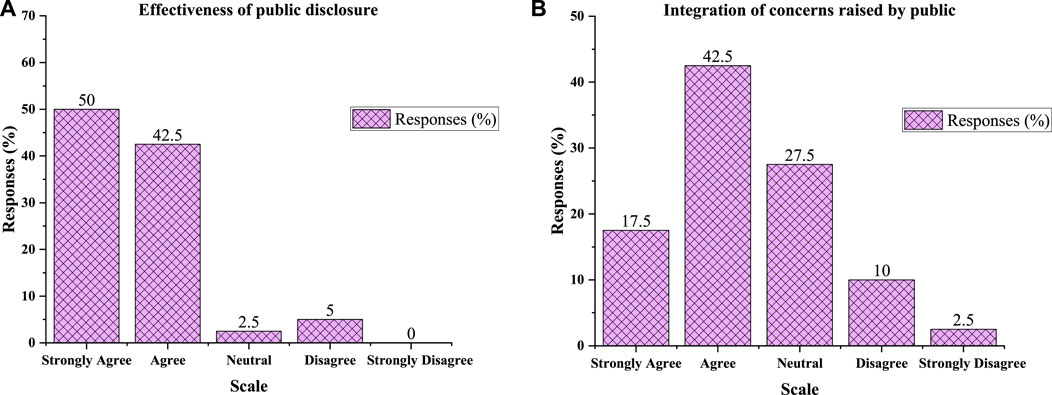
FIGURE 8. Stakeholders involvement. (A) Response about Effectiveness of Public disclosure during EIA (B) Response about Integration of concerns raised by public during EIA.
Moreover, 12.5% of respondents think that the concerns and opinions raised during the public consultation process have not been adequately addressed and integrated into the decision-making process as depicted in Figure 8B. The decision-making process can be made more transparent and inclusive, ensuring that various stakeholders’ perspectives are considered, and their opinions and concerns are adequately addressed in the decision-making process.
4.1.7 Consideration of climate change
Hydrological systems are of great importance as they greatly affect a region’s environmental and economic development. Climate change affects not only the hydrological, biological, and ecological systems but also the economy and life. 27.5% of respondents disagreed with the statement that the existing guidelines incorporate climate change considerations in the EIA process for hydropower projects in Pakistan, as expressed in Figure 9, which strongly highlights the need to update the existing guidelines keeping Climate change impacts in view.
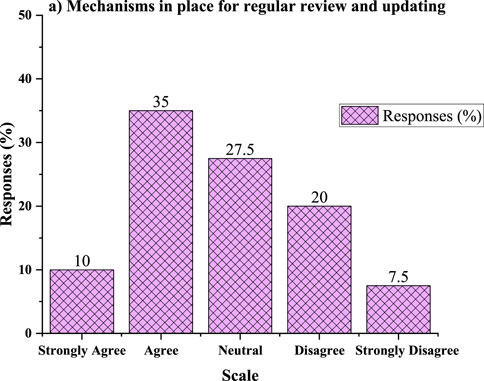
FIGURE 9. Response about incorporation of climate change in the EIA process for hydropower projects.
4.1.8 Alignment with international guidelines
The developed countries are more concerned about EIA and keep updating their EIA guidelines. As elaborated in Figure 10A, 25% of respondents think that the existing guidelines followed in Pakistan are not aligned with international standards and practices for Hydropower in real practice. Moreover, 25% of respondents/Decision makers disagreed about their familiarity with international guidelines/practices for EIA and mitigation measures in the hydropower sector as shown in Figure 10B. The reasons are partly implemented policies together with no structural reforms in Pakistan. So, EIA guidelines must be aligned with the international guidelines followed in developed countries, and the decision-makers must have proper training and up-to-date knowledge to keep advancement in the current era.
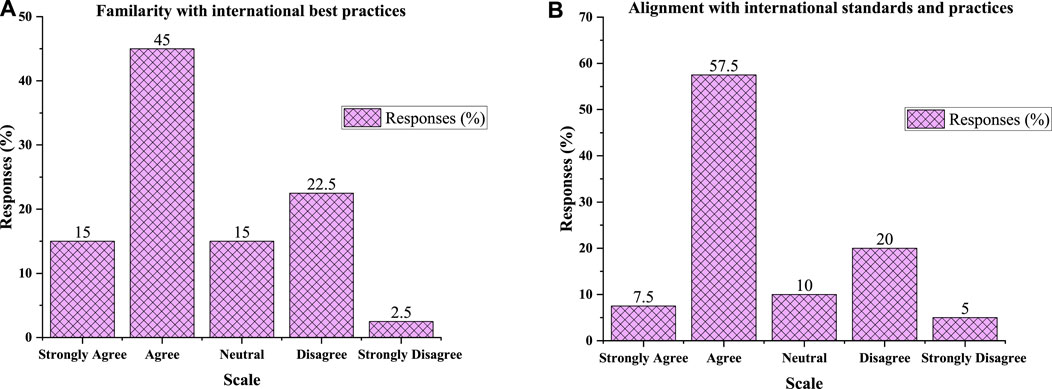
FIGURE 10. (A) Response about Familarity with international best practices (B) Response about alignment with international guidelines and practices.
4.1.9 Mechanism for updating existing guidelines
Everything in the Universe needed evolution and updates to work smoothly and efficiently. In developed countries, EIA guidelines are updated regularly to incorporate the new challenges. In Pakistan, only 45% of respondents agreed that there is a mechanism in place for regular review and updating of the existing guidelines, 27.5% disagreed with it, as depicted in Figure 11. There must be a proper mechanism to adopt the changes and keep the guidelines updated with respect to time.
4.2 Response after public consultation
To get the response and feedback about the implementation of the EIA guidelines for Hydropower projects in Pakistan, a scientific Questionnaire was prepared, and responses were collected from the Educated Public living in the influenced areas/regions in Pakistan where any Hydropower Project/Dam project was/will be in construction or operational Phase. One hundred two responses were collected, shown below question by question.
The authors targeted the educated community only for public consultation because of the scientific questionnaire, including the Engineers, particularly Civil Engineers, Water Resources Engineers, Teachers, Doctors, Lawyers, and higher education students i.e., Masters/PhD, etc. Besides this, the study preferred the people who live in the affected areas where they’ve observed or seen the development of hydropower projects.
4.2.1 Concerned area/project of influence
Out of 102 respondents from the different regions of Pakistan who were/are/will be affected or stakeholders during the EIA process for the development of a Hydropower Project in their area, including, Mangla Dam (37.3%), Tarbela Dam (9.8%), Neelum Jhelum Hydropower Project (13.7%), Gulpur Hydropower Project Kotli (6.9%), Kurram Tangi Dam (2.9%), Kohala Hydropower Project (6.9%), Karora Hydropower Project (8.8%), Diamer Basha Hydropower Project (4.9%), etc. as depicted in Figure 12.
4.2.2 Education status of respondents
The Questionnaire was shared with the persons with high qualifications. Just 3.9% of respondents were below graduation. More than 40% of respondents were graduated, more than 42% were post-graduated, and more than 13% of respondents had a doctoral degree, as shown in Figure 13.
4.2.3 Stakeholders involvement
One of the most important parts of any EIA process is the involvement of stakeholders. The prominent individuals involved in implementing a large-scale public project are stakeholders. First, the decision-makers responded about the stakeholders’ involvement, and here in this section, Local community/stakeholders were asked about it. In response to the accessibility and clarity of information provided to the public regarding a proposed hydropower project, more than 92% of respondents rated three and above on a 5-point scale, as shown in Figure 14A. Around 73% of respondents agreed that their opinions and concerns regarding the environmental impact of the project were adequately considered during the public consultation process in Pakistan as shown in Figure 14B. It highlights that the respondents agreed that the public is preferred to be involved in the decision-making process for the Hydropower project in Pakistan.

FIGURE 14. Response about stakeholders involvement. (A) Response about accessibility and clarity of information during EIA (B) Response about consideration of public opinion and concern during EIA.
4.2.4 Mitigation measures and resettlement
The major and important step for the public/local community is the mitigation measures and resettlement as their concerns were raised. The responses from the most important phase of the questionnaire from the public, i.e., Mitigation Measures and Resettlement, are shown in Figure 15. More than 71% of respondents (Figure 15A) agreed that the measures to ensure the protection of local communities, ecosystems, and cultural heritage during the project’s implementation are considered in the EIA process in Pakistan. It means that existing EIA guidelines incorporate mitigation measures for potential environmental impacts in Pakistan.
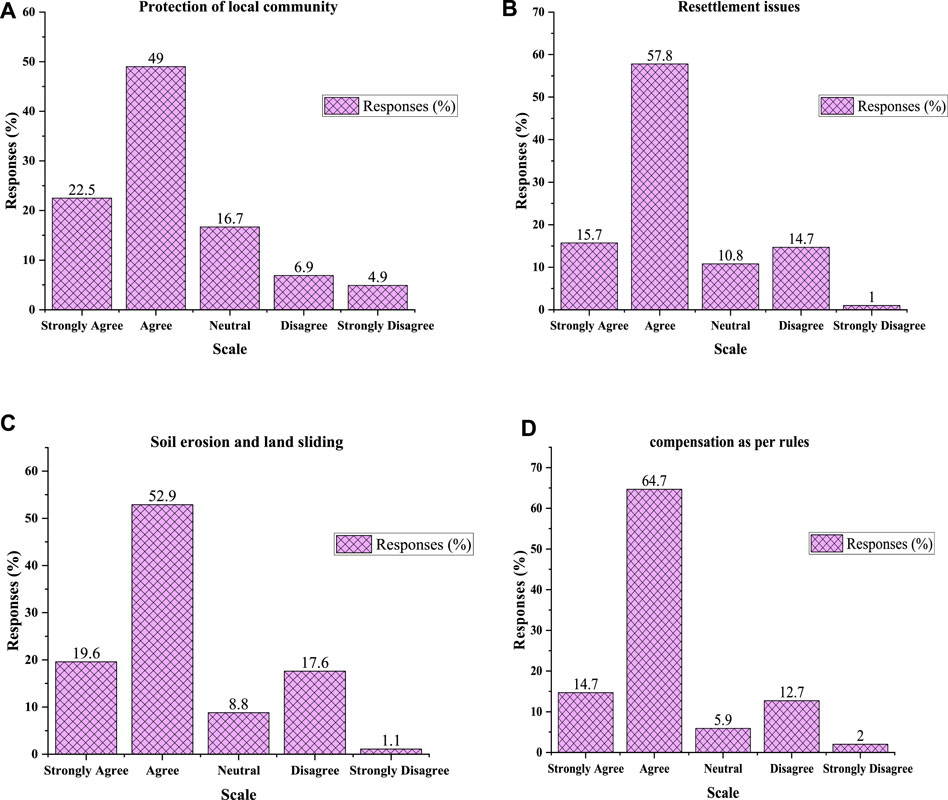
FIGURE 15. Response about mitigation measures and resettlement. (A) Response about Protection of local community during EIA (B) Response about resettlement issues during EIA (C) Response about measures for soil erosion and land sliding (D) Response about compensation as per rules.
Resettlement is part of the mitigation measures during EIA processes, mostly in the hydropower projects with storage reservoirs. Moreover, around 16% of respondents disagreed as highlighted in Figure 15B that the resettlement issues that occurred in their area during the Hydropower Project construction were well managed by the authorities as per rules. 73.5% of respondents agreed with that, highlighting the working of the mitigation process. It just needs to be strengthened. Around 19% of respondents (Figure 15C) think that authorities have not focused well on avoiding Soil Erosion and Land Sliding during and after project implementation in their area, which is a big concern as soil erosion and land sliding are the reasons for the sea level rise, including the increase in sediments ratio in water bodies. Around 80% of respondents (Figure 15D) think that the suffering persons/communities are compensated as per rules while applying EIA guidelines to a specific project in Pakistan. That is a good indication, and it should be up to 100%, besides updating the EIA guidelines.
4.2.5 Employment
The employment at any hydropower project within the area of influence should be the right of any affected community. As depicted in Figure 16, around 70% of respondents agreed that employment to local people/affected persons was/will be given according to their skill abilities and qualifications in their project area.
4.2.6 Solid waste management
When solid waste is improperly disposed of, the waste builds up and creates a threat to the public and the environment. 73.5% of respondents think that the authorities have properly managed the solid waste during the construction of hydropower projects in their area as depicted in Figure 17. Developing a livable and sustainable environment requires effective waste management, which highlights more care for solid waste management during the construction of hydropower projects.
4.2.7 Socio-economy and sustainability
More than 78% of respondents think the existing guidelines account for socio-economic considerations associated with hydropower projects and environmental impacts, as shown in Figure 18. It highlighted that the EIA guidelines followed in Pakistan encourage sustainable economic development alongside hydropower projects because Economic sustainability seeks to raise living standards. In contrast, social sustainability concentrates on enhancing social equality.
4.2.8 Nature and ecosystem
The habitats must be identified, described, and mapped during the site visits. In response to the questions related to Ecosystem and Biodiversity, more than 75% of respondents think the existing EIA guidelines encourage incorporating nature-based solutions and ecosystem services in the planning and design of hydropower projects as elaborated in Figure 19A. Moreover, more than 16% of respondents think that Flora and Fauna are not considered while applying EIA guidelines to a specific project in Pakistan as previewed in Figure 19B. It highlights that the EIA Guidelines should be followed when determining the value of ecological resources, characterizing the impacts of proposed development, evaluating the significance of those impacts, and assessing any residual effects.
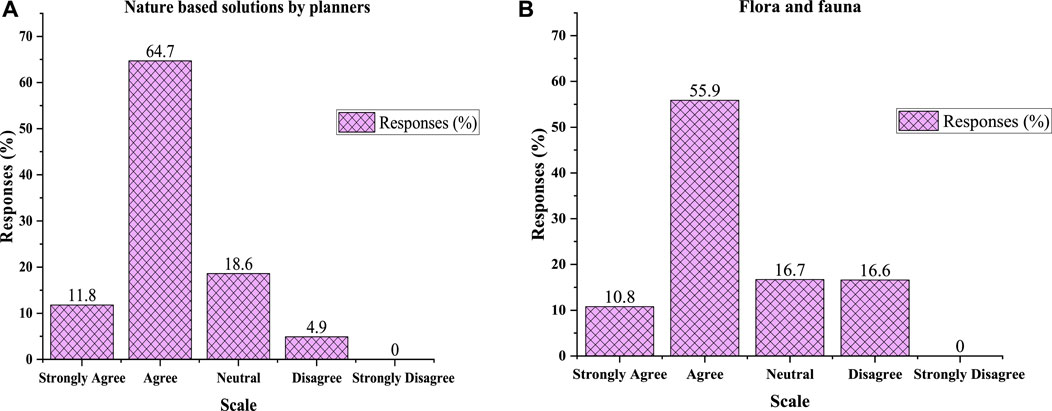
FIGURE 19. (A) Response about Nature based solutions by planners (B) Response about flora and fauna, ecosystem and biodiversity.
5 Discussion
The vast amount of available research on EIA, many diverse contributions have been made to evaluate the effectiveness of national EIA systems (Hagler Bailly Pakistan, 2018; Dutch Sustainability Unit, 2015). The importance of EIA for both small- and large-scale hydropower projects has been highlighted by numerous scholars across the globe. The responses to the questionnaires may not be very high; however, it can be observed from the results and through documents review that an adequate mechanism of EIA for hydropower development is available, and donors like the Asian Development Bank and World Bank observe the implementation process of EIA in Pakistan (Asian Development Bank, 2018; Asian Development Bank, 2021). However, several things that can be improved are observed during the analysis of decision-makers responses and the public feedback, not only in the institutional framework but also in actual implementation and practices.
Many researches have worked about assessing the EIA/hydropower through different methodologies. (McManamay et al., 2020). came up with a dataset of eco-evidence tools to inform early-stage environmental impact assessments of hydropower development. Users can determine which environmental indicators are most uncertain and need more research, as well as those that could be impacted by hydropower development, using a science-based questionnaire with a predictive model. Similarly, (Erlewein, 2013), investigated the structural boundaries of environmental assessment for hydropower development in Himachal Pradesh, India. Using a qualitative approach that included field observations, interviews with environmental specialists, and document reviews, the study concluded that the current practice of restricting EIAs to projects misses the chance to address the broader implications of major hydropower development. Thus, a critical investigation was conducted into the possibility of using the Strategic Environmental Assessment (SEA) paradigm to address contemporary issues.
Looking at the results, Figures 3–11 depict the findings about the responses to the questionnaire filled out by the decision-makers in the field of hydropower working on EIA about how they feel about the existing guidelines of EIA and how the mechanism is in process in Pakistan for the development of Hydropower projects. Observing all the responses to the questions asked, it is evident that the mechanism of EIA exists and is followed in Pakistan for the development of hydropower projects but needs to be updated and aligned with international guidelines. Also, there should be international-level training of the officers and decision-makers, i.e., WAPDA, for better efficiency. Statistically, 20%–30% of the shortcomings were noticed in some areas which were needed to be addressed.
Similarly, for analyzing public/local community feedback, Figures 14–19 depict the findings about the responses after public consultation about EIA for hydropower projects in Pakistan. The respondents (102) were from the different regions of Pakistan who were/are/will be affected or stakeholders during the EIA process for developing a hydropower project in their area. The questionnaire was shared with the persons with high qualifications. Statistically, consideration of public opinion and concerns, consideration of Flora and Fauna, soil erosion and land sliding management and resettlement issues were the areas where more than 10% public disagreed about the implementation of guidelines. Subsequently observing the responses by the stakeholders after public consultation, it is evident that there is a mechanism in place for EIA during the development of hydropower projects in Pakistan, and the mechanism needs to be 100% followed as per rules and guidelines. It needs to be strengthened by aligning it with international guidelines. Human, social, economic, and environmental steps must be considered while framing the EIA of hydropower projects. People should be communicated with and educated about the environmental impact on a vast basis.
EIA, in brief, has a limited impact on decision-making due to several factors, including a lack of funding and technical resources. The reasons could be the multidirectional priorities of the decision-makers and government, including political instability, which leads to economic crises and short-term policies as renewable energy is currently seeing a meteoric rise in popularity as a means of halting climate change, reducing carbon emissions, and converting to a more sustainable way of life. Understanding efficiency, sustainability, and prices is helpful when comparing solar versus hydropower. Hydropower conversion is more efficient; with current hydro turbines, over 90% of the energy in the water may be converted into electrical power. Solar panels only convert 15%–25% of the Sun’s energy into useable power. However, solar technology is increasing efficiency. Solar has a better environmental impact than hydro. As solar panels are in use, they produce very little emissions. Hydropower creates reservoirs on previously undeveloped land, disturbs river flows, and traps silt, altering the area’s ecologies. However, solar arrays also need much land (Allen, 2023). So, being a developing country and having a mega shortfall of electricity for years, besides the solar power development, Pakistan needs to focus on more hydropower development for affordable and cheap rates while strictly following the EIA guidelines, as just the Indus River in Pakistan has a potential of 60 GW; however, only 19% of it has been identified or used (Butt et al., 2023a).
6 Conclusion
With positive indicators that energy is becoming more broadly available and sustainable, the world is moving closer to achieving Sustainable Development Goal 7 (SDG 7). Pakistan is one of the emerging nations with suitable legal EIA provisions. Pakistan became the first nation in the world to include the Sustainable Development Goals (SDGs) in its national development strategy. Pakistan has made significant investments to address energy shortages, boost energy production, and increase access to electricity to advance SDG 7 more quickly. Hydropower, a sustainable energy source, is the need of hour for developing countries like Pakistan.
A comprehensive analysis of the EIA system identifies several things that can be improved further, including those in the organizational framework, implementation, and actual practices. The influence of EIA on decision-making is weak, owing to several reasons, including inadequate technical and financial matters. So, it is the need of the hour to enhance stakeholder engagement, conduct comprehensive baseline studies, assess cumulative impacts, integrate climate change considerations, evaluate alternative sites, prioritize biodiversity conservation, manage water flow regimes, and ensure effective monitoring and enforcement of mitigation measures. For future directions, there must be a think tank with relevant experts who can meet the needs of present and future epochs. People should be communicated and educated about the environmental impact on a vast basis to care for the environment. There should be international-level training of the officers and decision-makers, i.e., WAPDA, for better efficiency for future hydropower projects. This type of surveys provides a quick response of the targeted stakeholders and can be easily analyzed after receiving. The researcher can target the specific audience to achieve precise and genuine feedback.
Talking about possible direction of development of hydropower, along with completing the ongoing, protracted hydropower projects quickly and completing the mitigation measures of EIA, Pakistan should look for additional new hydropower potential sites in the Upper Indus Basin as there is a need for new Renewable energy sources, i.e., hydropower, while concentrating on SDG 7.
The study is limited to the analysis of the official documents and EIA reports by the Asian Development Bank, etc., and considered the feedback of the decision makers in Pakistan in the field of EIA implementations including public consultations through the scientific questionnaires. The study just targeted educated people for feedback through google form. The study collected feedback from 102 respondents and can be expanded in future by collecting larger number of responses to get more accuracy. The study focused on some specific factors to prepare the questionnaires, which can be expanded in future.
Data availability statement
The raw data supporting the conclusion of this article will be made available by the authors, without undue reservation.
Author contributions
AB: Conceptualization, Formal Analysis, Methodology, Writing–original draft, Writing–review and editing. DS: Conceptualization, Funding acquisition, Resources, Supervision, Writing–review and editing. YD: Project administration, Supervision, Writing–review and editing. AB: Validation, Writing–review and editing. WS: Validation, Writing–review and editing. MM: Writing–review and editing.
Funding
The author(s) declare financial support was received for the research, authorship, and/or publication of this article. This work was financially supported by an international partnership of the Chinese Academy of Sciences (Grant No. 131C11KYSB20200022), the Ministry of Science and Technology (Grant No. 2018FY100502), and Gansu Provincial Science and Technology Program (Grant No. 22ZD6FA005).
Acknowledgments
The authors would like to thank every person who has collaborated throughout the research work, mainly the officers and decision makers of the Water and Power Development Authority (WAPDA) Pakistan, for providing valuable responses to the scientific questionnaire. The completion of this research work could not have been possible without their feedback responses about the EIA questionnaire. The constructive contribution of WAPDA and the Public/Stakeholders and the anonymous referees’ careful review and sincere suggestions are gratefully acknowledged. The authors would also like to thank Dr. Khalid Qayyum Butt (AJK gov), Dr. Nasir Qayyum Butt (KSA), Dr. Muhammad Waseem (CEWRE, Lahore), Engr. Asad Islam (WAPDA), Engr. Hassan Raza Mehdi (WAPDA), Engr. Muhammad Hasnain Jillani (WAPDA), Engr. Mirza Sajid Baig (PWD AJK), and all friends and relatives, for their help in filling and spreading the questionnaires to the real stakeholders. The authors also thank Engr. Nazakat Hussain (General Manager, Diamer Basha Dam, WAPDA, Pakistan), and Engr. Khurram Taj (Planning Engineer, Power Development Organization, AJK, Pakistan) for provision of the relevant data and EIA literature including official documents to analyze during the research work.
Conflict of interest
The authors declare that the research was conducted in the absence of any commercial or financial relationships that could be construed as a potential conflict of interest.
Publisher’s note
All claims expressed in this article are solely those of the authors and do not necessarily represent those of their affiliated organizations, or those of the publisher, the editors and the reviewers. Any product that may be evaluated in this article, or claim that may be made by its manufacturer, is not guaranteed or endorsed by the publisher.
Abbreviations
ADB, Asian Development Bank; EIA, Environmental Impact Assessment; EPA, Environmental Protection Agency; EHS, Environment, Health & Safety; HPP, Hydropower Project; IFC, International Finance Corporation; SDG, Sustainable Development Goal; PEPO, Pakistan Environmental Protection Ordinance; SHP, Small Hydropower; SEA, Strategic Environmental Assessment; WAPDA, Water and Power Development Authority.
References
Afzal, M., Liu, T., Butt, A. Q., Nadeem, A. A., Ali, S., and Pan, X. (2023). Geospatial assessment of managed aquifer recharge potential sites in Punjab, Pakistan. Remote Sens. 15 (16), 3988. doi:10.3390/rs15163988
Ahamd, B., Ali, I., and Ahmad, S. (2009). Rapid environmental assessment of potential sites for Kohala hydropower project, 1–10.
Alaeddin, B. (2017). Environmental impact assessment of hydropower projects in Turkey: applications and problems. Fresenius Environ. Bull. 26 (2).
Allen, (2023). Hydro power vs. Solar energy: the ultimate showdown. Available: https://blog.ecoflow.com/us/hydro-power-vs-solar-energy/#:∼:text=HydroPowervs.SolarEnergy%3ATheUltimateShowdown.
Almazroui, M., Saeed, S., Saeed, F., Islam, M. N., and Ismail, M. (2020). Projections of precipitation and temperature over the south asian countries in CMIP6. Earth Syst. Environ. 4 (2), 297–320. doi:10.1007/s41748-020-00157-7
Annandale, D. (2014). SEA for hydropower development in Azad Jammu Kashmir state - Pakistan. https://www.commissiemer.nl/docs/mer/diversen/pos722-sea-hydropower-development.pdf.
Ansar, A., Flyvbjerg, B., Budzier, A., and Lunn, D. (2014). Should we build more large dams? The actual costs of hydropower megaproject development. Energy Policy 69, 43–56. doi:10.1016/j.enpol.2013.10.069
Asian Development Bank (2018). PAK: hydropower development investment Program, tranche 1, EIA of balakot hydropower project. Mandaluyong, Philippines: Asian Development Bank.
Asian Development Bank (2021). Environmental and social monitoring report: patrind hydropower project. Mandaluyong, Philippines: Asian Development Bank.
Bakken, T. H., Sundt, H., Ruud, A., and Harby, A. (2012). Development of small versus large hydropower in Norway comparison of environmental impacts. Energy Procedia 20, 185–199. doi:10.1016/j.egypro.2012.03.019
Banerjee, A., Chen, R., Meadows, M. E., Sengupta, D., Pathak, S., Xia, Z., et al. (2021). Tracking 21st century climate dynamics of the Third Pole: an analysis of topo-climate impacts on snow cover in the central Himalaya using Google Earth Engine. Int. J. Appl. Earth Obs. Geoinf. 103, 102490. doi:10.1016/j.jag.2021.102490
Banerjee, A., Kang, S., Meadows, M. E., Xia, Z., Sengupta, D., and Kumar, V. (2023). Quantifying climate variability and regional anthropogenic influence on vegetation dynamics in northwest India. Environ. Res. 234, 116541. doi:10.1016/j.envres.2023.116541
Botelho, A., Ferreira, P., Lima, F., Pinto, L. M. C., and Sousa, S. (2017). Assessment of the environmental impacts associated with hydropower. Renew. Sustain. Energy Rev. 70, 896–904. doi:10.1016/j.rser.2016.11.271
Butt, A. Q., et al. (2023b). Gradual changes in snow peaks in upper Indus Basin, Pakistan: a google earth based review. J. Mt. Area Res. 7, 37–43. doi:10.53874/jmar.v8i0.185
Butt, A. Q., Shangguan, D., Waseem, M., Haq, F. u., Ding, Y., Mukhtar, M. A., et al. (2023a). Ascertainment of hydropower potential sites using location search algorithm in hunza river basin, Pakistan. Water 15 (2929), 2929–3019. doi:10.3390/w15162929
Daini, P. (2000). Environmental impact assessment for hydroelectric power plants in trentino (Italy) 1990-1997: similarity and clustering of studies, sites and projects. Impact Assess. Proj. apprais. 18 (1), 43–60. doi:10.3152/147154600781767556
Diduck, A., Sinclair, J., Pratap, D., and Hostetler, G. (2007). Achieving meaningful public participation in the environmental assessment of hydro development: case studies from Chamoli District, Uttarakhand, India. Impact Assess. Proj. apprais. 25 (3), 219–231. doi:10.3152/146155107x217299
Dutch Sustainability Unit (2015). Environmental and social impacts associated with the proposed Gulpur hydropower project. State of Azad Jammu & Kashmir: Dutch Sustainability Unit.
Erlewein, A. (2013). Disappearing rivers - the limits of environmental assessment for hydropower in India. Environ. Impact Assess. Rev. 43, 135–143. doi:10.1016/j.eiar.2013.07.002
Google (2023). Google Forms. https://docs.google.com/forms/u/0/.
Government of Pakistan (2019). Pakistan’s implementation of the 2030 agenda for sustainable development goals - voluntary national review. https://www.switch-asia.eu/resource/pakistans-implementation-of-the-2030-agenda-for-sustainable-development/.
GRC (2016). Design, procurement and construction of Karora hydropower project (10.80 MW). https://grc.com.pk/design-procurement-and-construction-of-karora-hydropower-project-10-80-mw/.
Hagler Bailly Pakistan (2018). Arkari gol hydropower project environmental and social impact assessment. Islamabad, Pakistan: Hagler Bailly Pakistan.
Hanafi, J., and Riman, A. (2015). Life cycle assessment of a mini hydro power plant in Indonesia: a case study in karai river. Procedia CIRP 29, 444–449. doi:10.1016/j.procir.2015.02.160
Hoes, O. A. C., Meijer, L. J. J., Van Der Ent, R. J., and Van De Giesen, N. C. (2017). Systematic high-resolution assessment of global hydropower potential. PLoS One 12 (2), doi:10.1371/journal.pone.0171844
Jumani, S., Rao, S., Machado, S., and Prakash, A. (2017). Big concerns with small projects: evaluating the socio-ecological impacts of small hydropower projects in India. Ambio 46 (4), 500–511. doi:10.1007/s13280-016-0855-9
Kibler, K. M., and Tullos, D. D. (2013). Cumulative biophysical impact of small and large hydropower development in Nu River, China. Water Resour. Res. 49 (6), 3104–3118. doi:10.1002/wrcr.20243
Kuriqi, A., Pinheiro, A. N., Sordo-Ward, A., Bejarano, M. D., and Garrote, L. (2021). Ecological impacts of run-of-river hydropower plants—current status and future prospects on the brink of energy transition. Renew. Sustain. Energy Rev. 142, 110833. doi:10.1016/j.rser.2021.110833
Lata, R., Rishi, S., and Heroject, R. (2017). Environmental implications of the hydropower projects in district kinnaur, Himachal Pradesh India: a review. Res. J. 7301, 8–13.
Lee, N., and Tomkins, J. M. (1993). The quality of environmental impact statements in Ireland and the United Kingdom: a comparative analysis. Proj. Apprais. 8 (1), 31–36. doi:10.1080/02688867.1993.9726883
McDonald, K., Bosshard, P., and Brewer, N. (2009). Exporting dams: China’s hydropower industry goes global. J. Environ. Manage. 90 (Suppl. 3), S294–S302. doi:10.1016/j.jenvman.2008.07.023
McManamay, R. A., Parish, E. S., DeRolph, C. R., Witt, A. M., Graf, W. L., and Burtner, A. (2020). Evidence-based indicator approach to guide preliminary environmental impact assessments of hydropower development. J. Environ. Manage. 265, 110489. doi:10.1016/j.jenvman.2020.110489
Mira Power Limited (MPL) (2014). Environmental and social impact assessment; Gulpur hydropower project (Pakistan). Islamabad, Pakistan: Mira Power Limited MPL.
Muazzam, S. (2018). Land use conflicts and socioeconomic impacts nexus. Pakistan: A Case Study of Diamer Bhasha Dam Project.
Nadeem, O., and Hameed, R. (2008). Evaluation of environmental impact assessment system in Pakistan. Environ. Impact Assess. Rev. 28 (8), 562–571. doi:10.1016/j.eiar.2008.02.003
National Development Consultants (2007). Feasibility study of keyal khwar hydropower project. Lahore, Pakistan: National Development Consultants.
NEPRA (2019). National electric power regulatory authority (NEPRA). https://nepra.org.pk/tariff/Petitions.php.
NIAP (2014). EIA guidance for large-scale hydropower in Pakistan. Pakistan: National Impact Assessment Programme.
Ortolano, L., and Shepherd, A. (1995). Environmental impact assessment: challenges and opportunities. Impact Assess. 13 (1), 3–30. doi:10.1080/07349165.1995.9726076
Paliwal, R. (2006). EIA practice in India and its evaluation using SWOT analysis. Environ. Impact Assess. Rev. 26 (5), 492–510. doi:10.1016/j.eiar.2006.01.004
PEDO (2016). Karora hydropower project: Pakhtunkhwa energy development organization. https://pedokp.gov.pk/Main/psp/37.
Pinho, P., Maia, R., and Monterroso, A. (2007a). The quality of Portuguese Environmental Impact Studies: the case of small hydropower projects. Environ. Impact Assess. Rev. 27 (3), 189–205. doi:10.1016/j.eiar.2006.10.005
Pinho, P., Maia, R., and Monterroso, A. (2007b). The quality of Portuguese Environmental Impact Studies: the case of small hydropower projects. Environ. Impact Assess. Rev. 27 (3), 189–205. doi:10.1016/j.eiar.2006.10.005
Rajaram, T., and Das, A. (2006). Need for participatory and sustainable principles in India’s EIA system: lessons from the sethusamudram ship channel project. Impact Assess. Proj. apprais. 24 (2), 115–126. doi:10.3152/147154606781765237
Rashad, S. M., and Ismail, M. A. (2000). Environmental-impact assessment of hydro-power in Egypt. Appl. Energy 65 (1–4), 285–302. doi:10.1016/s0306-2619(99)00068-9
Sayadi, A., Khodadadi, D. A., and Partani, S. (2009). Environmental impact assessment of gotvand hydro-electric dam on the karoon river using ICOLD technique. Int. Sch. Sci. Res. Innov. 3 (6), 118–125.
Sengupta, D., Chen, R., Meadows, M. E., and Banerjee, A. (2020). Gaining or losing ground? Tracking Asia’s hunger for ’new’coastal land in the era of sea level rise. Sci. Total Environ. 732, 139290. doi:10.1016/j.scitotenv.2020.139290
Shangguan, D., Li, D., Ding, Y., Liu, J., Anjum, M. N., Li, Y., et al. (2021). Determining the events in a glacial disaster chain at badswat glacier in the karakoram range using remote sensing. Remote Sens. 13 (6), 1165–1216. doi:10.3390/rs13061165
Sinclair, A. J., and Diduck, A. P. (2000). Public involvement in environmental impact assessment: a case study of hydro development in kullu district, Himachal Pradesh, India. Impact Assess. Proj. apprais. 18 (1), 63–75. doi:10.3152/147154600781767637
Solomon, A. A., Child, M., Caldera, U., and Breyer, C. (2017). How much energy storage is needed to incorporate very large intermittent renewables? Energy Procedia 135, 283–293. doi:10.1016/j.egypro.2017.09.520
Souza-Cruz-Buenaga, F. V. A., Espig, S. A., Castro, T. L. C., and Santos, M. A. (2019). Environmental impacts of a reduced flow stretch on hydropower plants. Braz. J. Biol. 79 (3), 470–487. doi:10.1590/1519-6984.183883
Tzoumis, K., and Finegold, L. (2000). Looking at the quality of draft environmental impact statements over time in the United States: have ratings improved? Environ. Impact Assess. Rev. 20 (5), 557–578. doi:10.1016/s0195-9255(00)00061-5
Haq ul, F., Naeem, U. A., Ahmad, I., Waseem, M., and Iqbal, M. (2022). Electrical resistivity in the assessment of subsurface lithology and groundwater depth—a case study in Rawalpindi, Pakistan. Arab. J. Geosci. 15 (18), 1534–1537. doi:10.1007/s12517-022-10819-7
UNRIC (2023). Regional information centre for western europe. Available: https://unric.org/en/sdg-7/.
UN United Nations - Environment (2018). Assessing environmental impacts- A global review of legislation. Nairobi, Kenya: United Nations Environment Programme.
Wang, Q. G., Du, Y. H., Su, Y., and Chen, K. Q. (2012). Environmental impact post-assessment of dam and reservoir projects: a review. Procedia Environ. Sci. 13 (2011), 1439–1443. doi:10.1016/j.proenv.2012.01.135
Wende, W. (2002). Evaluation of the effectiveness and quality of environmental impact assessment in the Federal Republic of Germany. Impact Assess. Proj. apprais. 20 (2), 93–99. doi:10.3152/147154602781766735
Zarfl, C., Lumsdon, A. E., Berlekamp, J., Tydecks, L., and Tockner, K. (2015). A global boom in hydropower dam construction. Aquat. Sci. 77 (1), 161–170. doi:10.1007/s00027-014-0377-0
Zeleňáková, M., Fijko, R., Diaconu, D. C., and Remeňáková, I. (2018). Environmental impact of small hydro power plant—a case study. Environ. - MDPI 5 (1), 12–10. doi:10.3390/environments5010012
Zelenakova, M., Zvijakova, L., and Purcz, P. (2013). Small Hydropower Plant – Environ. Impact Assess. – Case Study 3 (4).
Zhang, X., Luo, J., Zhao, J., Xie, J., Yan, L., and Yu, Z. (2018). Simulation of the transboundary water quality transfer effect in the mainstream of the yellow river. Water 10, 974. doi:10.3390/w10080974
Keywords: hydropower, environmental impact assessment, public consultation, environment, decision makers
Citation: Butt AQ, Shangguan D, Ding Y, Banerjee A, Sajjad W and Mukhtar MA (2024) Assessing the existing guidelines of environmental impact assessment and mitigation measures for future hydropower projects in Pakistan. Front. Environ. Sci. 11:1342953. doi: 10.3389/fenvs.2023.1342953
Received: 22 November 2023; Accepted: 26 December 2023;
Published: 18 January 2024.
Edited by:
Deepak Kumar, University at Albany, United StatesReviewed by:
Alban Kuriqi, University of Lisbon, PortugalPaweł Tomczyk, Wroclaw University of Environmental and Life Sciences, Poland
Copyright © 2024 Butt, Shangguan, Ding, Banerjee, Sajjad and Mukhtar. This is an open-access article distributed under the terms of the Creative Commons Attribution License (CC BY). The use, distribution or reproduction in other forums is permitted, provided the original author(s) and the copyright owner(s) are credited and that the original publication in this journal is cited, in accordance with accepted academic practice. No use, distribution or reproduction is permitted which does not comply with these terms.
*Correspondence: Donghui Shangguan, ZGhndWFuQGx6Yi5hYy5jbg==
 Asim Qayyum Butt
Asim Qayyum Butt Donghui Shangguan
Donghui Shangguan Yongjian Ding
Yongjian Ding Abhishek Banerjee
Abhishek Banerjee Wasim Sajjad
Wasim Sajjad Muhammad Ahsan Mukhtar
Muhammad Ahsan Mukhtar